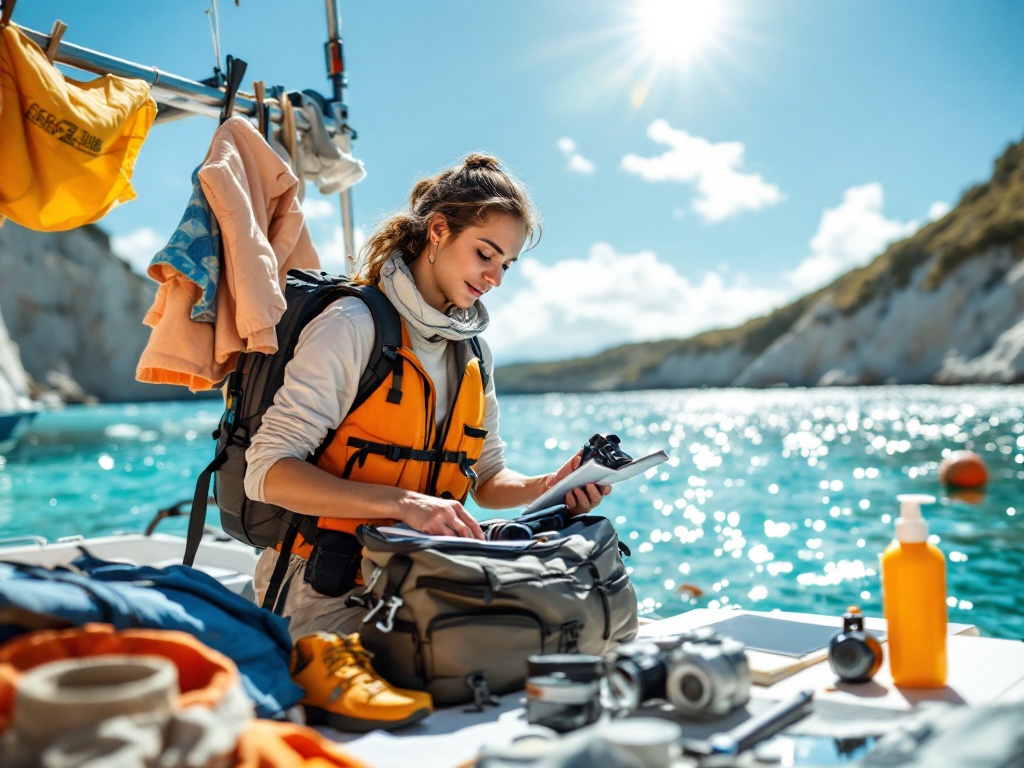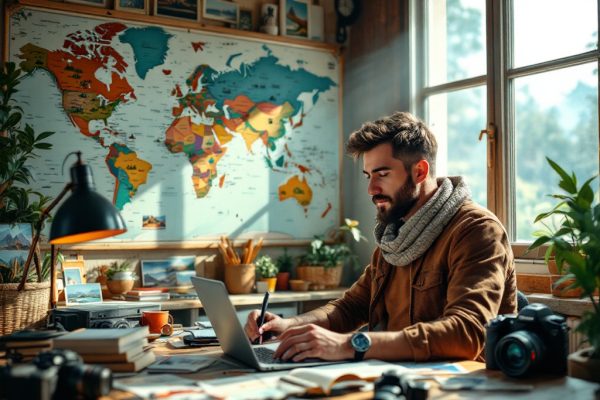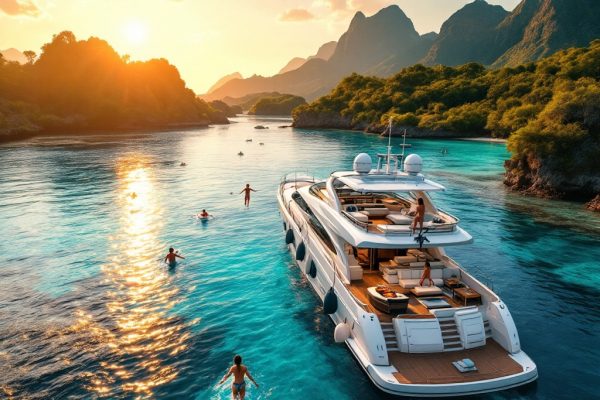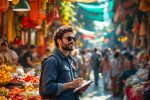Essentials when Traveling by Boat as a Journalist
Embarking on a boating trip as a journalist? Ensure a safe and productive voyage by preparing for unique challenges. This guide covers essential travel documents, vital safety procedures, and specialized gear like waterproof bags and quick-dry clothing. Learn how to protect valuable equipment, utilize portable power solutions, and prioritize health with seasickness medication and reef-safe sunscreen. Dive into the details now and capture your story with confidence.
Important information

- Safeguard essential electronics (cameras, laptops) using waterproof bags and padded cases. Back up your data to cloud storage for extra security.
- Pack crucial safety gear: life jacket, first-aid kit, VHF radio, and seasickness medication. Also include sun protection (hat, reef-safe sunscreen).
- Prepare for weather changes with lightweight, quick-drying clothing and foul-weather gear. Check marine weather forecasts before and during your trip.
- Bring backup camera equipment, batteries, and multiple memory cards to avoid missing critical shots due to technical issues or full storage.
- Ensure reliable power with portable power banks and solar chargers, especially for remote locations and extended filming sessions.
Preparing for a Boating Trip as a Journalist
Verify your travel documents. Ensure your passport and visa are valid to avoid unexpected issues.
Research your destination’s specific regulations and customs for a smooth and enjoyable experience.
Establish backup plans for unforeseen issues like unexpected weather changes or equipment malfunctions. Pack spare gear and set up alternative communication methods for emergencies.
Familiarize yourself with the boat’s safety procedures and the location of emergency equipment for both safety and a productive trip.
Evaluating Travel Documentation
Before starting your journey, verify your passport’s validity and acquire any required visas. Confirm your destination’s entry and exit regulations. Check for travel advisories or restrictions that might impact your trip.
Understanding Travel Challenges and Adaptability
Adapting to the motion of a boat can be challenging. Preemptive motion sickness medication can significantly ease the transition, allowing your body to adapt more comfortably.
Packing List and Travel Gear for Journalists
Packing Essentials for Journalists on Boat Trips
Electronics and Work Essentials
- Waterproof bag: crucial for safeguarding cameras, laptops, and other electronic devices from the elements.
- Notebooks: essential for jotting down observations and interview notes.
- Portable chargers: indispensable for keeping devices powered up while on the go.
Safety and Comfort
- Life jacket: a non-negotiable safety item for all boat trips.
- First-aid kit: a comprehensive kit to handle minor injuries or emergencies.
- Navigation tools: important for maintaining course and ensuring safe passage.
- Extra clothing layers: essential for adapting to fluctuating weather conditions.
- Sun protection: a hat, sunglasses, and sunscreen are vital for long days under the sun.
Using Waterproof Bags for Equipment Protection
Protect your valuable equipment with waterproof bags, especially electronics like cameras and laptops. Padded cases provide additional impact protection. Secure your belongings to prevent loss overboard. Regularly inspect your gear for wear and tear, and store it in a dry location when not in use. For extra data security, back up your files to cloud storage. This protects against data loss from equipment damage and provides convenient access from anywhere.
Use waterproof bags to protect sensitive electronics like cameras and laptops.
Use padded cases for extra protection against impacts.
Secure your items tightly to prevent them from going overboard.
Regularly inspect your equipment for wear and tear.
Store equipment in a dry place when not in use.
Back up your data to cloud storage for added security and accessibility.
Benefits of Lightweight Foul Weather Gear
For active sailors, lightweight foul-weather gear is a game-changer. It provides superior mobility and comfort while being incredibly packable. This is a huge plus for journalists who already carry lots of equipment, as it minimizes baggage weight. The specialized marine fabrics dry remarkably fast, ensuring comfort even in unpredictable maritime conditions and, importantly, helping prevent hypothermia and other cold-related dangers. This quick-drying capability is not just about comfort; it’s a vital safety feature.
Quick-Dry Clothing and Specialist Marine Fabrics
For boating journalists, quick-drying clothing is essential. Synthetic fabrics like nylon and polyester are ideal for shirts, shorts, and pants, wicking away moisture to keep you comfortable even when soaked. Specialized marine fabrics offer additional benefits such as UV protection, water resistance, and increased durability. Treated cotton and ripstop nylon are excellent choices. To save luggage space, roll your clothes or use vacuum packing.
Essential Camera and Audio Equipment
Essential Underwater Filming Equipment
- A waterproof camera is crucial for capturing stunning underwater footage.
- An underwater housing provides extra protection for your camera.
- A tripod helps stabilize your shots, ensuring clear and professional-looking footage.
- For audio recording, a waterproof microphone and a recorder are essential.
Backup Gear for Underwater Filming
- A second camera body serves as a backup in case of any issues with your primary camera.
- Extra batteries are vital for extended filming sessions.
- Plenty of memory cards ensure you have ample storage space for your footage.
- A portable hard drive provides additional storage and backup capabilities.
Reliable power is essential on any boat to maintain consistent operation of your filming equipment. Portable power solutions, like power banks and solar chargers, will keep your devices running smoothly, ensuring uninterrupted filming.
Data loss can be disastrous, so back up everything. Multiple memory cards prevent filming interruptions when storage is full. Portable chargers and power banks are invaluable for a consistent power supply, ensuring your devices are always ready to capture the action.
Importance of Backup Equipment and Memory Cards
Boating trip photojournalists should always pack backup camera gear. Technical malfunctions can occur, so extra equipment is crucial for capturing key moments.
Multiple memory cards are equally important. If one fails, your work is safeguarded. This redundancy also permits continuous shooting, ensuring you won’t miss a shot.
Portable Power Solutions and Portable Chargers
Power up your camera and audio equipment on the go with portable power banks and solar chargers. These portable solutions are essential for long shoots, especially in remote locations. Choose high-capacity power banks with multiple output ports for charging several devices at once. For sustainable charging and extended outdoor shoots, consider solar chargers that harness sunlight to replenish your power banks.
Health and Safety Essentials on a Boat
Protect yourself from the sun and insects with a hat and reef-safe sunscreen. This sunscreen not only protects your skin but also helps prevent stains on the boat. A secure hat is especially important on windy days, ensuring both comfort and safety.
Pack a well-stocked first-aid kit and seasickness medication. The kit helps treat minor injuries, while the medication can prevent queasiness during the trip.
For emergencies, ensure you have life jackets for every passenger and a VHF radio for communication. These are crucial safety measures that can be lifesavers in critical situations.
Sun and Insect Protection: Hat and Sunscreen
A wide-brimmed hat shields you from the sun. For added protection, apply a broad-spectrum, ocean-friendly sunscreen with an SPF of 30 or higher to guard against harmful UV rays.
First-aid Kit and Sickness Medication
A well-stocked first-aid kit is essential for treating minor injuries and common ailments. Don’t forget seasickness medication to alleviate nausea and discomfort, especially during boat travel. Packing both ensures a more comfortable and enjoyable trip.
Emergency Preparedness: Life Jackets and VHF Radio
Life jackets are crucial for safety, and everyone on board should have one readily available. A functioning VHF radio is equally important, not only for emergencies but also for daily navigation.
Travel Tips for Outdoor Photojournalists
Prioritizing safety in seafaring is crucial, and checking marine weather forecasts before and during your voyage is essential. A snorkeling kit enhances underwater photography and videography, providing outdoor photojournalists with more opportunities to capture stunning images and document marine life. However, even with advanced technology, safety must come first; always check marine weather forecasts.
Marine Weather Forecast and Travel Safety
Before setting sail, check the marine weather forecast, as sea conditions can change rapidly. Sudden storms and strong winds are serious hazards, so being well-prepared is crucial. Pack layers of clothing and waterproof gear to cope with significant temperature changes. It’s also wise to have a backup plan in case of weather-related delays or route alterations. Be ready for anything.
Snorkeling Kit for Underwater Coverage
Snorkeling paired with a waterproof camera housing opens a window to stunning underwater photography, allowing you to capture breathtaking perspectives beneath the waves. A dry snorkel enhances the experience by preventing water entry, even during dives. Fins provide essential control and maneuverability for effortless exploration of the marine world.
Advantages of using a dry snorkel:
- prevents water from entering the breathing tube, making breathing easier and more comfortable,
- allows for brief submersion without water entering the snorkel,
- reduces the need to clear the snorkel frequently.
Benefits of using fins:
- increase propulsion and efficiency in the water,
- reduce effort and fatigue while swimming, allowing for longer exploration,
- improve maneuverability and control, granting access to tighter spaces and intricate reefs.














